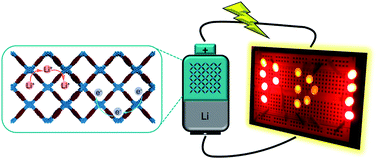π-Conjugated redox-active two-dimensional polymers as organic cathode materials†
Abstract
Redox-active two-dimensional polymers (RA-2DPs) are promising lithium battery organic cathode materials due to their regular porosities and high chemical stabilities. However, weak electrical conductivities inherent to the non-conjugated molecular motifs used thus far limit device performance and the practical relevance of these materials. We herein address this problem by developing a modular approach to construct π-conjugated RA-2DPs with a new polycyclic aromatic redox-active building block PDI-DA. Efficient imine-condensation between PDI-DA and two polyfunctional amine nodes followed by quantitative alkyl chain removal produced RA-2DPs TAPPy-PDI and TAPB-PDI as conjugated, porous, polycrystalline networks. In-plane conjugation and permanent porosity endow these materials with high electrical conductivity and high ion diffusion rates. As such, both RA-2DPs function as organic cathode materials with good rate performance and excellent cycling stability. Importantly, the improved design enables higher areal mass-loadings than were previously available, which drives a practical demonstration of TAPPy-PDI as the power source for a series of LED lights. Collectively, this investigation discloses viable synthetic methodologies and design principles for the realization of high-performance organic cathode materials.



 Please wait while we load your content...
Please wait while we load your content...